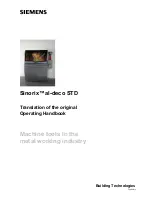
9 - English
WARNING:
When servicing, use only identical replacement parts.
Use of any other parts may create a hazard or cause
product damage.
WARNING:
Always wear eye protection with side shields marked to
comply with ANSI Z87.1. Failure to do so could result in
objects being thrown into your eyes resulting in possible
serious injury.
GENERAL MAINTENANCE
Avoid using solvents when cleaning plastic parts. Most
plastics are susceptible to damage from various types of
commercial solvents and may be damaged by their use. Use
clean cloths to remove dirt, dust, oil, grease, etc.
WARNING:
Do not at any time let brake fluids, gasoline, petroleum-
based products, penetrating oils, etc., come in contact
with plastic parts. Chemicals can damage, weaken, or
destroy plastic which may result in serious personal injury.
MAINTENANCE
NOTE: ILLUSTRATIONS START ON PAGE 10 AFTER
FRENCH AND SPANISH LANGUAGE SECTIONS.
WARNING:
Collected sanding dust from sand ing surface coatings
such as polyurethanes, linseed oil, etc., can self-ignite in
the sander dust bag or elsewhere and cause fire. To reduce
the risk of fire, always empty the dust bag frequently
(10-15 minutes) while sanding and never store or leave a
sander without totally emptying its dust bag. Also follow
the recommendations of the coatings manufacturers.
ATTACHING THE SANDER TO A VACUUM
See Figure 9, page 11.
The dust bag can be removed and a 1-1/4 in. or 1 - 7/8 in.
vacuum can be attached to the dust port.
Remove the battery pack.
Remove the dust bag.
Attach a vacuum hose to the dust exhaust port using a
slight twisting motion.
Connect the vacuum to a power supply.
OPERATION










































